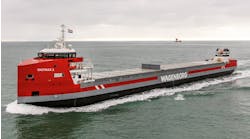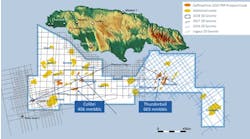BP Amoco and Arco - multinational major and very big independent. A match made in heaven? Maybe not. The marriage would create the largest non-state oil producer in the world, not to mention a coast-to-coast marketing company in the US.
BP Amoco's daily production will be increased by 360,000 boe/d by Arco's holdings in the US, both onshore and offshore, and by 100,000 boe/d from the UK. Across the world, BP Amoco's already huge reserves will be swelled by Arco's interests in gas reserves in Indonesia, the South China Sea, Malaysia, Thailand, and Qatar, and holdings in oil reserves in Algeria, Venezuela, the Caspian Sea, and Russia (where Arco holds 7.99% interest in Lukoil).
Sounds very promising, especially with an expected $1 billion a year in savings.
The Alaska problem
However, the sheer size of the coupling may be its undoing. The merger must be approved by the US Federal Trade Commission and the European Commission. And in the US, particularly in Alaska, opposition is gearing up.
Alaska is a very special case. Most of its revenues come from its huge oil reserves. The legendary North Slope and nearby fields are the heart of its wealth. If Arco is permitted to merge with BP Amoco, the company will then own 70% of Alaskan oil production and slightly more than 70% interest in the 800-mile Trans-Alaskan pipeline that carries crude oil to a southern port. Concerns about competition and lost jobs abound. There is also the fact that BP Amoco is based in London. The state of Alaska doesn't like the idea of a foreign multinational controlling its reserves.
BP Amoco CEO Sir John Browne played down concerns about competition, saying the company will seek to increase competitiveness for all industry players in the region. In truth, an Alaskan law allowing no more than 500,000 acres to be controlled by any one player will surely produce sales of the surplus 360,000 acres (presumably part of the planned $3 billion worldwide selloff). This could shift control of some very promising properties.
Nevertheless, the company would still control a nervous-making percentage of the reserves and production of the state. Alaskan Representative Jim Whitaker, Chairman of the Oil and Gas Committee, expressed concern that Alaska could become a "colony" of BP.
Besides some layoffs, the consolidation may also decrease the number of businesses awarded service contracts. If BP Amoco-Arco already has good terms negotiated, dealing with one firm rather than two would simplify paperwork and probably save money. Although the number of direct employees of the conglomerate expected to be laid off in Alaska is really fairly small, the contractors' business may fall off enough to hurt the state's employment numbers, some fear.
Pursuing Alaska gas
Perhaps to pacify Alaskan concerns about employment and continuing development, CEO Browne enticingly dangled the carrot of utilization of the large gas reserves of the North Slope as a promise of increasing wealth and employment for the state. He said most of the North Slope gas reserves are currently uneconomic to produce (most of it is now used for gas re-injection). Browne highlighted a plan to build a $70 million pilot gas-to-liquids plant near the North Slope to test technology - sidestepping the desire of Alaska to have a new gas pipeline built.
A gas pipeline would be hugely expensive - some estimates guess at $12-15 billion. If the technology works out, BP Amoco said, it would consider full-scale development. The company definitely has said it will locate its global gas technology group in Alaska.
Although the idea sounds promising for employment, Rep. Whitaker thinks he has a better idea: Force the combined company to give up its North Slope gas assets and establish an Alaska-owned state corporation to market these reserves. House Bill 170, which has been referred to committee, would establish the Alaska Gas Corp.
Whether the odds of this corporation's creation are good or not, it is certain that the BP Amoco-Arco merger will be closely watched by Alaska. The state legislature hired an outside law firm specializing in anti-trust law to assist the state's own attorneys in reviewing the merger. Gov. Tony Knowles also appointed a four-member team to review the prospective transaction. The team includes the state attorney general, the natural resources commissioner, special counsel to the governor, and - tellingly - the revenue commissioner. It intends to review the transaction for its effect on the economy, the environment, competition, and state revenue.
The governor's statements to the US Federal Trade Commission may well decide the success or failure of the approval. The FTC formally announced in early April it will be reviewing the transaction. Experts believe the FTC will pay particular attention to the Alaskan situation when reviewing the BP Amoco-Arco proposed merger. Although Arco has substantial holdings across the US, noticeably in the Gulf of Mexico through its 82.1% interest in large independent Vastar Resources, Alaska is the major sticking point.
European holdings
There are also European Commission concerns about the company's holdings in the North Sea. In the UK, new developments including Shearwater and Britannia, would fall to BP Amoco. The move would also mean BP Amoco having stakes in all but three of the major pipeline systems and terminals handling North Sea oil and gas. "This is an enviable position for any company but may raise concerns from other players over the control BP Amoco has," warned UK analysts Wood MacKenzie.
In short, the effort faces a regulatory and political fight on both sides of the Atlantic. Even if things go as planned and approval is granted by the end of the year, there may be internal problems as well.
Layoffs are a foregone conclusion. It is very clear that senior management of Arco will not be employees of the new company.
At year's end 1998, BP Amoco employed 96,650 people and Arco employed 18,400. BP Amoco said that once the companies have merged, they will lay off about 2,000 people worldwide, of which 15-20% will be in Alaska.
When BP and Amoco originally discussed their merger agreement, the layoff target was about 6,000 people. Eventually, 10,000 were laid off. Whether the 2,000 number is very conservative, only time will tell.
As this article is being written, both companies are subject to the US Securities and Exchange Commission's "quiet period," meaning they cannot discuss merger specifics in detail. Nevertheless, it is known that when BP and Amoco came together there was some tension about salaries and other compensation concerns. Other problems may include conflict between the extended future plans of the companies.
Only time will tell whether BP Amoco-Arco is meant to be. Regulatory concerns may nix the plans or cause divestitures which may cost more than the company wants to accept. Even if both the FTC and the European Commission allow the transaction, it may take some work to assure the smoothness of the merger.


